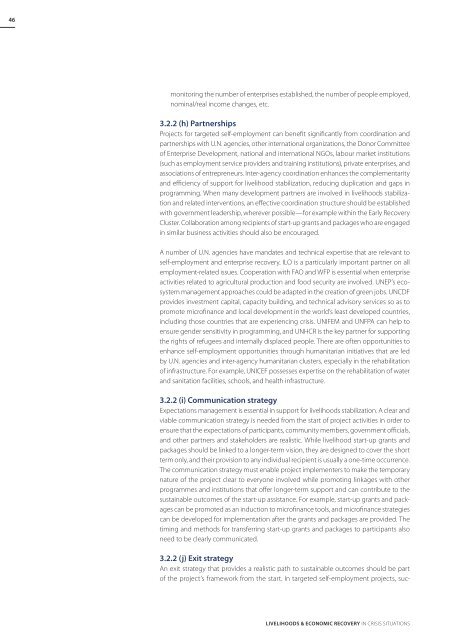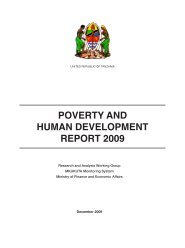Download PDF (4.08 MB) - ReliefWeb
Download PDF (4.08 MB) - ReliefWeb
Download PDF (4.08 MB) - ReliefWeb
Create successful ePaper yourself
Turn your PDF publications into a flip-book with our unique Google optimized e-Paper software.
46<br />
monitoring the number of enterprises established, the number of people employed,<br />
nominal/real income changes, etc.<br />
3.2.2 (h) Partnerships<br />
Projects for targeted self-employment can benefit significantly from coordination and<br />
partnerships with U.N. agencies, other international organizations, the Donor Committee<br />
of Enterprise Development, national and international NGOs, labour market institutions<br />
(such as employment service providers and training institutions), private enterprises, and<br />
associations of entrepreneurs. Inter-agency coordination enhances the complementarity<br />
and efficiency of support for livelihood stabilization, reducing duplication and gaps in<br />
programming. When many development partners are involved in livelihoods stabilization<br />
and related interventions, an effective coordination structure should be established<br />
with government leadership, wherever possible—for example within the Early Recovery<br />
Cluster. Collaboration among recipients of start-up grants and packages who are engaged<br />
in similar business activities should also be encouraged.<br />
A number of U.N. agencies have mandates and technical expertise that are relevant to<br />
self-employment and enterprise recovery. ILO is a particularly important partner on all<br />
employment-related issues. Cooperation with FAO and WFP is essential when enterprise<br />
activities related to agricultural production and food security are involved. UNEP’s ecosystem<br />
management approaches could be adapted in the creation of green jobs. UNCDF<br />
provides investment capital, capacity building, and technical advisory services so as to<br />
promote microfinance and local development in the world’s least developed countries,<br />
including those countries that are experiencing crisis. UNIFEM and UNFPA can help to<br />
ensure gender sensitivity in programming, and UNHCR is the key partner for supporting<br />
the rights of refugees and internally displaced people. There are often opportunities to<br />
enhance self-employment opportunities through humanitarian initiatives that are led<br />
by U.N. agencies and inter-agency humanitarian clusters, especially in the rehabilitation<br />
of infrastructure. For example, UNICEF possesses expertise on the rehabilitation of water<br />
and sanitation facilities, schools, and health infrastructure.<br />
3.2.2 (i) Communication strategy<br />
Expectations management is essential in support for livelihoods stabilization. A clear and<br />
viable communication strategy is needed from the start of project activities in order to<br />
ensure that the expectations of participants, community members, government officials,<br />
and other partners and stakeholders are realistic. While livelihood start-up grants and<br />
packages should be linked to a longer-term vision, they are designed to cover the short<br />
term only, and their provision to any individual recipient is usually a one-time occurrence.<br />
The communication strategy must enable project implementers to make the temporary<br />
nature of the project clear to everyone involved while promoting linkages with other<br />
programmes and institutions that offer longer-term support and can contribute to the<br />
sustainable outcomes of the start-up assistance. For example, start-up grants and packages<br />
can be promoted as an induction to microfinance tools, and microfinance strategies<br />
can be developed for implementation after the grants and packages are provided. The<br />
timing and methods for transferring start-up grants and packages to participants also<br />
need to be clearly communicated.<br />
3.2.2 (j) Exit strategy<br />
An exit strategy that provides a realistic path to sustainable outcomes should be part<br />
of the project’s framework from the start. In targeted self-employment projects, suc-<br />
Livelihoods & Economic Recovery in Crisis Situations





